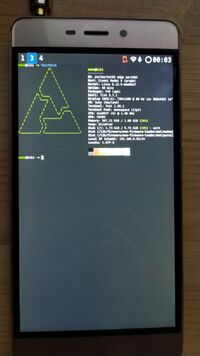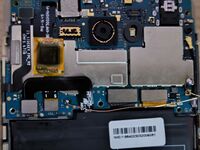Xiaomi Redmi 4 Standart (xiaomi-prada)
Appearance
| This device is supported as part of a generic port. Refer to Generic MSM89x7 (qcom-msm89x7) for installation instructions and more information. |
 xiaomi-prada showing fastfetch | |
| Manufacturer | Xiaomi |
|---|---|
| Name | Redmi 4 Standart |
| Codename | xiaomi-prada |
| Released | 2016 |
| Type | handset |
| Hardware | |
| Chipset | Qualcomm Snapdragon 430 (MSM8937) |
| CPU | Octa-core 1.4 GHz Cortex-A53 |
| GPU | Adreno 505 |
| Display | 720x1280 IPS |
| Storage | 16/32 GB |
| Memory | 1/2/3 GB |
| Architecture | aarch64 |
| Software | |
Original software The software and version the device was shipped with. |
Android (MIUI) 6.0.1 |
Extended version The most recent supported version from the manufacturer. |
Android (MIUI) |
| FOSS bootloader | lk2nd |
| postmarketOS | |
| Category | testing |
Mainline Instead of a Linux kernel fork, it is possible to run (Close to) Mainline. |
yes |
pmOS kernel The kernel version that runs on the device's port. |
6.13 |
| Generic port | Generic MSM89x7 (qcom-msm89x7) |
| Device package |
|
| Kernel package |
|
Flashing Whether it is possible to flash the device with pmbootstrap flasher. |
Works
|
|---|---|
USB Networking After connecting the device with USB to your PC, you can connect to it via telnet (initramfs) or SSH (booted system). |
Works
|
Internal storage eMMC, SD cards, UFS... |
Works
|
SD card Also includes other external storage cards. |
Works
|
Battery Whether charging and battery level reporting work. |
Works
|
Screen Whether the display works; ideally with sleep mode and brightness control. |
Works
|
Touchscreen |
Works
|
| Multimedia | |
3D Acceleration |
Works
|
Audio Audio playback, microphone, headset and buttons. |
Works
|
Camera |
Partial
|
Camera Flash |
Works
|
IR TX |
Broken
|
| Connectivity | |
WiFi |
Works
|
Bluetooth |
Works
|
GPS |
Broken
|
| Modem | |
Calls |
Broken
|
SMS |
Broken
|
Mobile data |
Broken
|
| Miscellaneous | |
FDE Full disk encryption and unlocking with unl0kr. |
Works
|
USB OTG USB On-The-Go or USB-C Role switching. |
Works
|
| Sensors | |
Accelerometer Handles automatic screen rotation in many interfaces. |
Works
|
Magnetometer Sensor to measure the Earth's magnetism |
Works
|
Ambient Light Measures the light level; used for automatic screen dimming in many interfaces. |
Partial
|
Proximity |
Works
|
Haptics |
Broken
|
| This device is based on the Snapdragon 430. See the SoC page for common tips, guides and troubleshooting steps |
Installation
- Follow the Installation guide
| Warning: Flashing lk2nd is required, as it is a hard dependency. |
$ pmbootstrap init # choose Vendor: qcom Device codename: msm89x7
$ pmbootstrap install
$ fastboot flash boot lk2nd.img # Build it from msm8916-mainline/lk2nd
$ pmbootstrap flasher flash_rootfs
Device Notes
Sensors
Connected to i2c-gpio
| Sensor | Model | Status |
|---|---|---|
| Accelerometer/Gyroscope | bosch,bmi120 (bosch,bmi160) | Works |
| Light/Proximity | liteon,ltr559 (liteon,ltr501) | Works |
| Magnetometer | yamaha,yas537 (yamaha,yas530) | Works |
UART
The working voltage is 1.8 V.
Warning: the test points are very small, soldering is not recommended. It's probably better to just hold a wire with a hard thin end with your hands.

How to enter flash mode
[Power] + [Vol-] to fastboot mode
Users owning this device
- NekoCWD (Notes: Lab rat, running postmarketOS)